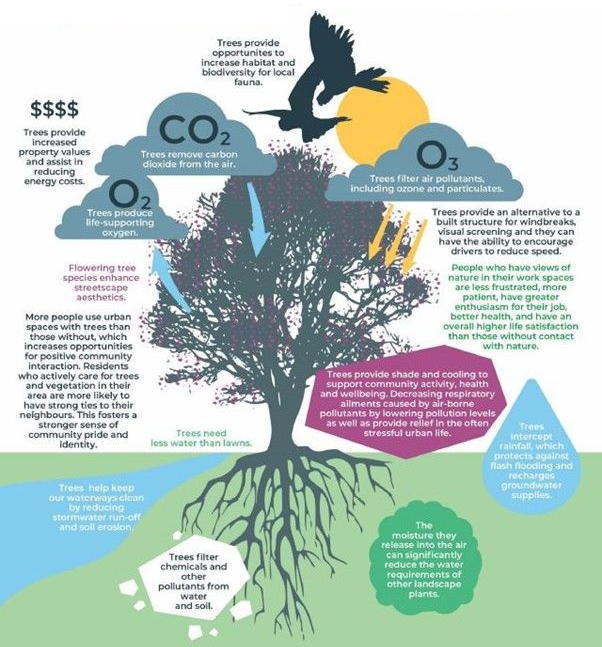Trees located on the street verge are only to be pruned or removed by the City or its contractors.
Pruning is periodically scheduled by the City to ensure that trees located under overhead power lines are maintained to meet guidelines in accordance with road safety and Western Power requirements.
Residents can contact the City to request an inspection or maintenance should they have concerns regarding the health, location or safety of a tree.
Please note: The City is not responsible for the maintenance of trees in new estates. For queries contact the relevant developer.
Request for new trees
Property owners can request a tree to be planted on the verge next to their property by completing our online street tree request form, however as tree stocks are limited, supply cannot be guaranteed.
Removal of street trees
The City does not support the removal of healthy, stable and viable trees and will not consider the removal of trees for reasons such as to reduce leaf litter or to improve or create views., Request are to be addressed to the City by phone or email and City officers will inspect and consider removal in accordance with Councils policy for tree removal.
Street tree pruning
City of Mandurah completes powerline pruning and maintenance on an annual schedule. Contact the City at 9550 3777 for more information on the schedule.
The City's Tree Preservation Areas are a part of our greening strategy to protect mature trees and the benefits they provide.
This scheme is not limited to City-owned trees. Trees in your backyard are a key part of our environment and contribute to local biodiversity and our sense of place.
To nurture and grow our canopy throughout the city, permission must be sought from the City for any works in these areas. The topping, lopping, removing, pruning, transplanting, filling or excavating around, injuring, or destruction of any bushland or tree(s), with a height greater than 3 metres is prohibited in these areas without permission from the City.
How are Tree Preservation Areas determined?
Tree Preservation Areas are:
- All land within 120 m of the high watermark of a watercourse or the boundary of riparian vegetation for non-tidal affected wetlands
- land with a slope above 10%
- Land that is zoned Residential with a density coding of R2, R2.5 or R5
- All other zoned land with a lot area greater than 4000m2
- Land that is nominated as a Tree Preservation Area as part of an Outline Development Plan
- Or where a tree or bushland is registered or nominated for registration on the City's Significant Tree Register.
How to check if your property is in a Tree Preservation Area:
- Check our mapping system
- Under Modules select Town Planning
- Under Layers select Tree Preservation Areas
- Search for your address
- Or call the City on 9550 3777 for help.
Whether an approval is required or not, before undertaking any tree removal, pruning or other vegetation removal check carefully for any fauna. Properties located south of the Dawesville Cut may provide habitat for Western Ringtail Possums (Critically Endangered) and / or Black Cockatoos (Endangered). There are also potential occurrences of threatened ecological communities in Parklands, Herron, Bouvard, Lake Clifton.
The Biodiversity Conservation Act 2016 and Biodiversity Conservation Regulations 2018 provide protection for biodiversity, particularly threatened species and threatened ecological communities. If a threatened species or ecological community is present on your property, you may be required to obtain a permit from the Department of Biodiversity, Conservation and Attractions.
Please use the contact details below for advice.
Species and Communities Program
Department of Biodiversity, Conservation and Attractions
Locked Bag 104
Bentley Delivery Centre WA 6983
Email:
FAQs about trees
Native trees do not only absorb carbon dioxide and potentially harmful gasses and release oxygen, but one large tree can supply a day's supply of oxygen for four people, in addition to also providing food and habitat for our local wildlife. Many of these local wildlife depend on mature, hollow-bearing trees for their very survival. These trees can take many decades to form and cannot be replaced once cut down, hence the City’s collaboration with residents to safely keep as many of these invaluable tree assets as possible.
The City of Mandurah have developed a Locality Street Tree Masterplan for the entire City to support the City's strategic direction and policy on trees as well as inform the future tree planting initiatives to create a more sustainable City.
Not only are trees essential for life, but as the longest living species on earth, they give us a link between the past, present and future. (https://www.royalparks.org.uk) Like all living things, trees grow, mature, sometimes suffer from illness and eventually senesce and die. It is therefore imperative that the City have a guiding strategy and plan to deal with all its street trees.



